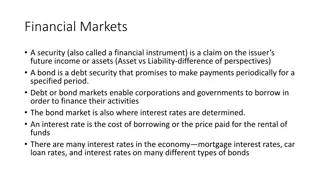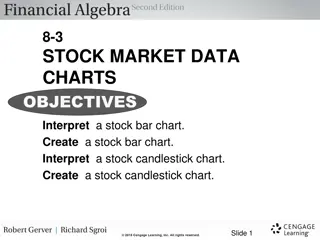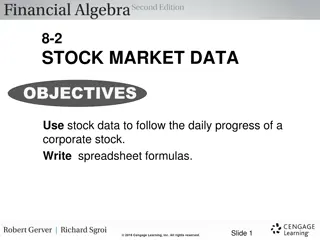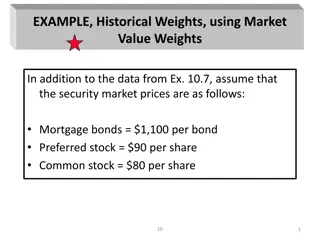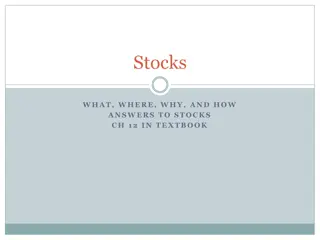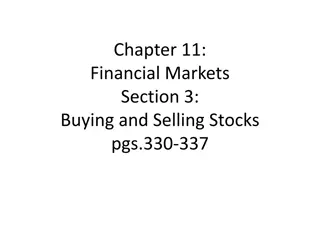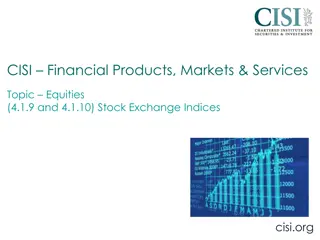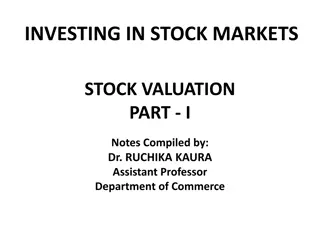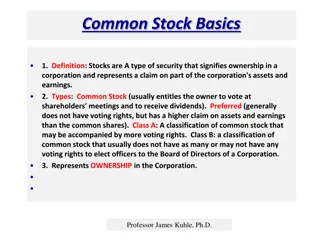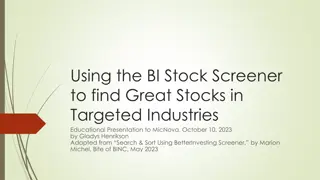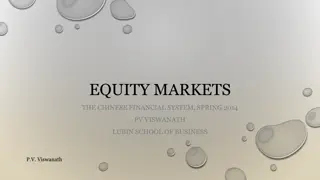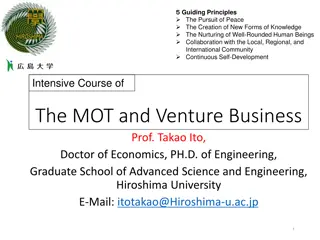Understanding Stock Types and Evaluation
This content covers the basics of buying and selling stocks, evaluating different types of stocks, valuing stock prices, and understanding the benefits of owning stock. It discusses common stock, preferred stock, income stocks, growth stocks, and various stock investments. The information provided aims to help readers grasp the features and valuation of stocks, enabling them to make informed investment decisions.
Download Presentation

Please find below an Image/Link to download the presentation.
The content on the website is provided AS IS for your information and personal use only. It may not be sold, licensed, or shared on other websites without obtaining consent from the author. Download presentation by click this link. If you encounter any issues during the download, it is possible that the publisher has removed the file from their server.
E N D
Presentation Transcript
12 12.1 Buying and Selling Stock Evaluating Stocks 12.2
Schedule Review Test Scattegories P.P.-Types of Stock W.S. Different Types of Stocks P.P.-Valuing Stock P.P.-Stock Price and Indexes Examples of Overvalued vs. Undervalued Stocks Online Stock Game Chapter 12 SLIDE 2
Evaluating Stocks GOALS Describe features of stock and types of stocks. Explain how to value a stock and decide a fair price to pay for a stock purchase. Chapter 12 SLIDE 3
Owning Stock Nearly 50 million people in the United States own stocks. People who own shares of stock are called stockholders, or shareholders, of the corporation. Two ways to profit from owning stock: Dividends are money paid to stockholders from the corporation s earnings (profits). Capital gain is an increase in the value of the stock over time. Chapter 12 SLIDE 4
Common Stock Common stock represents a type of stock that pays a variable dividend and gives the holder voting rights. A proxyis a stockholder s written authorization to transfer his or her voting rights to someone else, usually a company manager. Chapter 12 SLIDE 5
Preferred Stock Preferred stock represents a type of stock that pays a fixed dividend but has no voting rights. Preferred stockholders earn the stated dividend, regardless of how the company is doing. Preferred stock is less risky than common stock. Dividends on preferred stock may be lower than common stockholders would earn, if the company is thriving over time. Chapter 12 SLIDE 6
Common VS Preferred SLIDE 7
Types of Stock Investments Income stocks- Growth stocks- Emerging stocks- Blue chip stocks- Defensive stocks Cyclical stocks- Chapter 12 SLIDE 8
W.S. Different Types of Stocks SLIDE 9
Income Stocks and Growth Stocks Income stocks are stocks that have a consistent history of paying high dividends. Growth stocks are stocks in corporations that reinvest their profits into the business so that it can grow. Chapter 12 SLIDE 10
Emerging Stocks and Blue Chip Stocks Emerging stocks are stocks in young, often small corporations that have higher overall risk than stocks of companies that have been successful for many years. Blue chip stocks are stocks of large, well-established corporations with a solid record of profitability. Chapter 12 SLIDE 11
Defensive Stocks and Cyclical Stocks A defensive stock, or non-cyclical stock, is one that remains stable and pays dividends during an economic decline. Cyclical stocks do well when the economy is stable or growing but often do poorly during recessions, when the economy slows down. Chapter 12 SLIDE 12
Valuing Stock Market value is the price for which the stock is bought and sold in the marketplace. Chapter 12 SLIDE 13
Stock Price Factors that affect price include: The company Interest rates The market Earnings per share Chapter 12 SLIDE 14
Return on Investment Because you can make money on stocks from dividends and from an increase in the price of the stock (capital gain), you should consider both when computing the return on your investment. Your profit is the difference between what you paid for the stock and what you sold it for, plus any dividends you earned. To compute the total costs, add any commission you paid to the stockbroker to the purchase price of the stock. Chapter 12 SLIDE 15
Stock Indexes A stock index is a benchmark that investors use to judge the performance of their investments. Examples of commonly used indexes include: Dow Jones Industrial Average Standard & Poor s 500 NASDAQ Composite Index Chapter 12 SLIDE 16
Go to thestreet.com Find some overvalued and undervalued stocks and use them to purchase stock SLIDE 17
Schedule Review P.P.-Bull Vs Bear White board breakdowns-Types of Investing Math Problems- Selling Short and Dollar-Cost Avg Reading a stock listing in a newspaper How the Market Works HW: Read Sec 1 Chapter 14 SLIDE 18
Lesson 12.2 Buying and Selling Stock GOALS Describe the process of buying and selling stocks. Describe short- and long-term investment strategies when buying and selling stocks. Explain how to read the stock listings and stock indexes. Chapter 12 SLIDE 19
The Securities Market A securities exchange is a marketplace where brokers who are representing investors meet to buy and sell securities. The over-the-counter (OTC) market is a network of brokers who buy and sell the securities of corporations that are not listed on a securities exchange. Chapter 12 SLIDE 20
Bull and Bear Markets A bull market is a prolonged period of rising stock prices and a general feeling of investor optimism. A bear market is a prolonged period of falling stock prices and a general feeling of investor pessimism. Chapter 12 SLIDE 21
Investing Strategies Short-term techniques Buy on margin Sell short Long-term techniques Buy and hold Dollar-cost averaging Direct investment Reinvesting dividend Chapter 12 SLIDE 22
Buy on Margin You can borrow money from your broker to buy stock if you open a margin account and sign a contract called a margin agreement. Leverage is the use of borrowed money to buy securities. When the market value of a margined stock decreases to approximately one-half of the original purchase price, the investor will receive a margin call from the broker. This means the investor must pledge additional cash or securities to serve as collateral for the loan. Chapter 12 SLIDE 23
Sell Short Short selling is selling stock borrowed from a broker that must be replaced at a later time. To sell short, you borrow a certain number of shares from the broker. You then sell the borrowed stock, knowing that you must buy it back later and return it to the broker. You are betting that the price will drop, so that you can buy it back at a lower price than you sold it for, thus making a profit. Chapter 12 SLIDE 24
Long-Term Investing Techniques Buy and hold Dollar-cost averaging Direct investment Reinvesting dividends Chapter 12 SLIDE 25
Buy and Hold Most investors consider stock purchases as long- term investments. All stocks go up and down, but over a number of years, the overall trend of non-speculative stocks is moderately up. If you buy and hold stocks for many years, you can ride out the down times. When you are ready to sell years later, most likely your stock will have gained value. In addition, many stocks pay dividends, so you are earning income while you hold the stock. Chapter 12 SLIDE 26
Dollar-cost Averaging The dollar-cost averaging technique involves the systematic purchase of an equal dollar amount of the same stock at regular intervals. The result is usually a lower average cost per share. Chapter 12 SLIDE 27
Direct Investment You can save money using direct investment, or buying stock directly from a corporation. By buying directly, you avoid brokerage and other purchasing fees. You may also be able to obtain shares at prices lower than on open exchanges. Chapter 12 SLIDE 28
Reinvesting Dividends Dividend reinvestment means using dividends previously earned on the stock to buy more shares. Buying stock this way avoids a broker fee and other costs that apply, such as taxes, when you receive cash dividends on the stock. Chapter 12 SLIDE 29
Reading the Stock Listings Excerpt from stock exchange listings: 52 Wks P/E Ratio Sales 100s Net High Low Stock Div Yld% High Low Close Change 1 2 3 4 5 6 7 8 9 10 11 58.75 44.00 Enger 2.20 4.8 12 109 46.38 45.50 46.00 .50 45.00 23.00 Eng pf 2.25 8.9 10 25 26.25 24.00 25.38 +.38 10.50 9.00 Entld .10 1.0 3 8 10.13 9.50 10.00 ---- 24.00 16.00 Epsco 1.00 5.0 7 12 21.00 19.00 20.00 +.88 6.38 4.00 Exlab ---- ---- 15 300z 5.75 5.12 5.50 ---- 57.00 32.00 ExeB 2.50 5.7 11 48 46.00 43.00 44.00 +1.00 Chapter 12 SLIDE 30
14 14.1 Investing in Mutual Funds
Schedule King of the Hill Types of Funds W.S. Morningstar Fund Research How the Market Works Game- Buying mutual funds 401k Research HW: None SLIDE 32
Lesson 14.1 Investing in Mutual Funds GOALS Discuss mutual funds as an investment strategy. Explain how to buy and sell mutual funds. SLIDE 33 Chapter 14
Mutual Funds A mutual fund is a professionally managed group of investments bought using a pool of money from many investors. Individuals buy shares in the mutual fund. The fund managers use this pooled money to buy stocks, bonds, and other securities. The kinds of securities they buy depend on the fund s stated investment objectives. SLIDE 34 Chapter 14
Advantages of Mutual Funds Professionally managed Liquid Diversified Require only a small minimum investment SLIDE 35 Chapter 14
Mutual Fund Growth funds- Income funds- Growth and income funds- Money market funds- Global funds- Index funds- SLIDE 36 Chapter 14
Growth Funds A growth fund is a mutual fund whose investment goal is to buy stocks that will increase in value over time. SLIDE 37 Chapter 14
Income Funds An income fund is a mutual fund whose investment goal is to produce current income in the form of interest or dividends. SLIDE 38 Chapter 14
Growth and Income Funds A growth and income fund is a mutual fund whose investment goal is to earn returns from both dividends and capital gains. A balanced fund is a mutual fund that seeks both growth and income but attempts to minimize risk by investing in a mixture of stocks and bonds rather than stocks alone. SLIDE 39 Chapter 14
Money Market Funds A money market fund is a mutual fund that invests in safe, liquid securities, such as Treasury Bills and bonds that mature in less than a year. SLIDE 40 Chapter 14
Global Funds A global fund is a mutual fund that purchases international stocks and bonds as well as U.S. securities. SLIDE 41 Chapter 14
Index Funds An index is an average of the price movements of certain selected securities. Investors use indexes as benchmarks for comparison to judge how well their investments are doing. An index fund is a mutual fund that tries to match the performance of a particular index by investing in the companies included in that index. SLIDE 42 Chapter 14
Risk and Return Pyramid Higher risk/higher return potential Growth Funds Growth and Income Funds Income Funds Lower risk/lower return potential Money Market Funds SLIDE 43 Chapter 14
The Prospectus The prospectus is a legal document that offers securities or mutual fund shares for sale. It must contain the following: The terms A summary of the fund s portfolio of investments The fund s objectives Financial statements showing past performance SLIDE 44 Chapter 14
Costs and Fees If you buy a mutual fund through a broker, you will likely have to pay a sales fee, called a load. Front-end load Back-end load No-load fund SLIDE 45 Chapter 14
The Mutual Fund Company You have no guarantees that a mutual fund will make money or that the mutual fund company itself will not fail. To reduce these risks, choose a mutual fund company that has the following characteristics: It has been in business for 20 or more years It has a solid track record of returning good solid returns to investors It is a large company that manages investments for millions of investors It is a well-known company that is highly respected among investment advisers and experts It exists both in brick-and-mortar and in cyberspace It is customer friendly and responsive to customer questions and needs It provides customers with easy-to-read statements and reports and offers daily online access SLIDE 46 Chapter 14
Schedule 401 K Research and review 2 Truths and Lie HW: None SLIDE 47
Lesson 14.1 Investing in Mutual Funds GOALS Discuss mutual funds as an investment strategy. Explain how to buy and sell mutual funds. SLIDE 48 Chapter 14
1. Who or what is the text about? 2. What connection does this text have to our class? 3. What questions do you have about the text? 4. Are there any words or terms that you don t understand or are curious about? 5. What are comments or quotes that you found most interesting from the text





